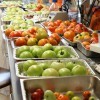Abstract
Non-typhoidal Salmonella has emerged as one of the problematic human pathogens associated with fresh produce, nuts, and complex foods containing them. Recent research shows that some varieties of plants are more “resistant” to colonization by the pathogens than others. This raises the intriguing possibility that cultivar selection could be used to identify crop varieties that may be less conducive to proliferation of human pathogens. This 3-page fact sheet provides up-to-date information about tomato production practices and their relationships with Salmonella. Written by Massimiliano Marvasi, George Hochmuth, and Max Teplitski, and published by the UF Department of Soil and Water Science, December 2014. (Photo: Max Teplitski, UF/IFAS)
References
Barak, J. D., L. C. Kramer, and L. Y. Hao. 2011. "Colonization of tomato plants by Salmonella enterica is cultivar dependent, and type 1 trichomes are preferred colonization sites." Appl Environ Microbiol 77: 498-504. https://doi.org/10.1128/AEM.01661-10
Batz, M. B., S. Hoffman, and J. G. Morris. 2011. Ranking the risks: the 10 pathogen-food combinations with the greatest burden on public health. Gainesville, FL: University of Florida, Emerging Pathogens Institute.
DeWaal, C. S., X. A. Tian, and D. Plunkett. 2009. Outbreak Alert! Center for Science in Public Interest.
Gutierrez-Rodriguez, E., A. Gundersen, A. O. Sbodio, and T. V. Suslow. 2012. "Variable agronomic practices, cultivar, strain source and initial contamination dose differentially affect survival of Escherichia coli on spinach." J Appl Microbial 112: 109-118. https://doi.org/10.1111/j.1365-2672.2011.05184.x
Jablasone, J., K. Warriner, and M. Griffiths. 2005. "Interactions of Escherichia coli O157:H7, Salmonella typhimurium and Listeria monocytogenes plants cultivated in a gnotobiotic system." Int J Food Microbiol 99: 7-18. https://doi.org/10.1016/j.ijfoodmicro.2004.06.011
Klerks, M. M., E. Franz, M. van Gent-Pelzer, C. Zijlstra, and A. H. van Bruggen. 2007. "Differential interaction of Salmonella enterica serovars with lettuce cultivars and plant-microbe factors influencing the colonization efficiency." Isme J 1: 620-631. https://doi.org/10.1038/ismej.2007.82
Lopez-Velasco, G., A. Sbodio, A. Tomas-Callejas, P. Wei, K. H. Tan, et al. 2012. "Assessment of root uptake and systemic vine-transport of Salmonella enterica sv. Typhimurium by melon (Cucumis melo) during field production." Int J Food Microbiol 158: 65-72. https://doi.org/10.1016/j.ijfoodmicro.2012.07.005
Marvasi, M., C. E. Cox, Y. Xu, J. T. Noel, J. J. Giovannoni, et al. 2013. "Differential regulation of Salmonella typhimurium genes involved in O-antigen capsule production and their role in persistence within tomato fruit." Mol Plant Microbe Interact 26: 793-800. https://doi.org/10.1094/MPMI-09-12-0208-R
Marvasi, M., A. S. George, M. Giurcanu, G. J. Hochmuth, J. T. Noel, et al. 2014. "Effects of nitrogen and potassium fertilization on the susceptibility of tomatoes to post-harvest proliferation of Salmonella enterica." Food Microbiol 43: 20-27. https://doi.org/10.1016/j.fm.2014.03.017
Marvasi, M., G. J. Hochmuth, M. C. Giurcanu, A. S. George, J. T. Noel, et al. 2013. "Factors that affect proliferation of Salmonella in tomatoes post-harvest: the roles of seasonal effects, irrigation regime, crop and pathogen genotype." PLoS One 8: e80871. https://doi.org/10.1371/journal.pone.0080871
Marvasi, M., J. T. Noel, A. S. George, M. A. Farias, K. T. Jenkins, et al. 2014. "Ethylene signalling affects susceptibility of tomatoes to Salmonella." Microb Biotechnol 7: 545-555. https://doi.org/10.1111/1751-7915.12130
Poza-Carrion, C., T. V. Suslow, and S. E. Lindow. 2013. "Resident bacteria on leaves enhance survival of immigrant cells of Salmonella enterica." Phytopathology 103. https://doi.org/10.1094/PHYTO-09-12-0221-FI
Quilliam, R. S., A. P. Williams, and D. L. Jones. 2012. "Lettuce cultivar mediates both phyllosphere and rhizosphere activity of Escherichia coli O157:H7." PLoS One 7: e33842. https://doi.org/10.1371/journal.pone.0033842
Shi, X., A. Namvar, M. Kostrzynska, R. Hora, and K. Warriner. 2007. "Persistence and growth of different Salmonella serovars on pre- and postharvest tomatoes." J Food Prot 70: 2725-2731. https://doi.org/10.4315/0362-028X-70.12.2725
Williams, T. R., A. L. Moyne, L. J. Harris, and M. L. Marco. 2013. Season, irrigation, leaf age, and Escherichia coliinoculation influence the bacterial diversity in the lettuce phyllosphere. PLos One 8: e68642. https://doi.org/10.1371/journal.pone.0068642

